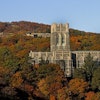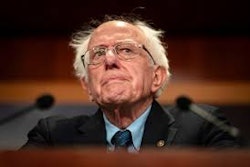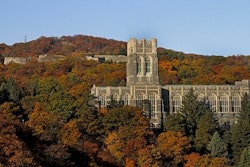Under Fire
ALABAMA A&M UNIVERSITY PERSIDENT FORCED TO RESIGN AMID STRING OF CONTROVERSIES
By Tracie Powell
 NORMAL, Ala.
NORMAL, Ala.
Like previous school presidents before him, Dr. John T. Gibson’s tenure at Alabama A&M University has been marked by turmoil and scandal. Gibson weathered the storm longer than some, but last month trustees forced him to resign.
Problems, some apparently spurred by unhappy employees, others by Gibson himself, include missing money, mismanagement, lawsuits and ego trouble. But in the end, and despite some progress made under his administration, negative perception is what trustees say finally convinced them that it was Gibson’s time to go.
Trustees and Gibson are currently negotiating his exit, but his departure may not come cheap. His contract with the university doesn’t run out until 2007, terminating it early could cost the university upwards of $850,000.
Forcing Gibson to leave now could put the university in dire straights, alumni and employees complain, causing relations between the two parties to get even nastier than they already are.
Gibson didn’t return several phone calls to his office for this story, but Black Issues talked with state officials, alumni, trustees and current employees in hopes of getting a glimmer into what went wrong.
To understand how the relationship between Gibson and Alabama A&M soured, one must start prior to Gibson’s arrival.
Knowing the History
Dr. Richard “R.D.” Morrison became president of Alabama A&M in 1962, and remained in that position for more than 20 years. After Morrison retired, there was a secession of presidents. Even the infamous conservative Republican Alan Keyes, who ran against U.S. Sen. Barack Obama, D-Ill., in November, held the post for a while as an interim president.
When Gibson took the helm in 1996, poor morale plagued faculty and staff and student enrollment had hit an all-time low. Controversies, financial and otherwise, had swallowed up the school’s previous leaders. Gibson was brought aboard to provide stability.
In the nearly nine years he has been on campus, Gibson has overseen the renovation and repair of several buildings on campus and the construction of a new residence hall, stadium and soccer fields. A new wellness center is on the horizon as well. Under his leadership, faculty and staff saw their salaries increase significantly and student enrollment increase to 6,600.
The coup de grace — this year A&M was cited as one of America’s Best Colleges by U.S. News and World Report magazine.
“This is the most prosperity we have ever seen,” says Willie Lightford, an accountant in the school’s library who has worked at the university for 20 years. “You can just look across campus and see all he’s done. Now anybody would want to stick their chest out.”
Lightford, like others, is despondent because Gibson is leaving. She doesn’t blame him for what’s gone wrong at A&M, “he’s but one person,” she says. Lightford believes that Gibson’s forced departure has more to do with politics; she faults trustees placed on the board by Republican Gov. Bob Riley. As governor, Riley is de facto chairman of A&M’s board of trustees.
“Any negative perception we have is there because they created it,” Lightford says. “But what they don’t understand is that the damage that’s being done is beyond just (Gibson). It’s affecting the morale of the students as well as people in the community.”
A&M’s relationship with state leaders has been tense for years. Stories have circulated about how former A&M presidents had to grovel for funds from legislators. Their White counterparts, such as the University of Alabama, didn’t have to do that. “After that kind of humiliation and injustice, it takes years to rebuild trust,” wrote Huntsville Times columnist David Person.
“Ask the right people and they’ll tell you that it stung when the University of Alabama in Huntsville was founded in A&M’s back yard in 1961…,” Person continues. “They’ll remind you that A&M was already here — had been for nearly a century at that point — and would have been the logical place to begin training scientists and engineers. They’ll maintain that all of the resources and funding funneled to UAH could have been invested in A&M.”
It’s likely that because of racism and segregation it didn’t happen, especially since A&M retained its historically Black identity.
These days, according to Person, A&M and the University of Alabama-Huntsville seem to co-exist peacefully, thanks perhaps to conscious efforts by Gibson, who worked to ease lingering tensions and partnered with UAH where possible.
But distrust persists as A&M supporters and others in the Black community continue to suspect that A&M’s very existence might be in jeopardy, Person says. Fears that A&M might be forced to merge with a historically White institution ran especially high in the days when news headlines focused on the long-running desegregation lawsuit filed by A&M and Alabama State University to give the state’s Black colleges and universities their fair share of state funding and resources.
In one of his columns, Person hints that Gov. Riley may have been behind Gibson’s ouster.
Malcolm Thomas, the governor’s liaison to historically Black colleges and universities, balks at that allegation. As director of the state’s Historically Black Colleges and Universities Commission, Thomas recommends trustees to the governor, who then appoints them to the respective boards.
Criteria to become a trustee include having an academic or business background and also having the ability to raise and/or contribute money to the institution, Thomas says.
“A&M has never, in its history, had a board who could go out and raise money,” Thomas says. “And if you really look at the history — that board was conceptualized in 1973 and came to fruition in 1975 — in a period of 30 years, that board itself has not raised $25,000 or $30,000. It’s pitiful.”
But what’s more pitiful, Thomas adds, is that Gibson has not raised any money for the school either. “He has not raised a quarter, not to my knowledge,” Thomas says. “I can’t think of $5 that John Gibson has raised to help Alabama A&M.”
Perception is Everything
While Thomas, whose wife is chairman of A&M’s English and Foreign Language Department, questioned Gibson’s financial contributions to the school, a university spokesman credits Gibson with launching the Councill Challenge. The fund, which has led to allegations and questions for Gibson as well, currently exceeds $20 million, the spokesman says. The money is raised from corporations, alumni and foundations and is primarily used for student scholarships.
But for all the good Gibson has done, there are a number of glaring setbacks, according to media reports and records obtained by Black Issues:
— In 1997, the faculty senate conducted a vote of “no confidence” in President Gibson. Then-faculty senate president Regina Colston attempted to present the group’s findings to the board of regents, but she was removed from the meeting by campus security. During the meeting, the board gave the president a two-year contract extension and a raise.
— In 1999, another faculty senate president, Dr. Chandra Reddy, circulated a petition calling for President Gibson to step down, criticizing his leadership during the university’s financial trouble at that time.
— Controversy popped up again in 1999, when a group of alumni accused Gibson of criminal activity, saying he violated the state’s open bidding law during the previous year’s Magic City Classic. The annual rivalry between A&M and Alabama State University is one of the biggest social events, and most successful fund-raisers, among the two Black colleges and the city of Birmingham.
— In January of 2000, the board of trustees placed Gibson’s wife, Voncile, on administrative leave. She oversaw the university’s ROTC program. There were charges that $90,000 was misdirected. Mrs. Gibson soon retired under a cloud of suspicion.
— In August of 2000, following complaints from an employee, trustees asked Gibson for an explanation of how a corporate donors’ account of more than $100,000, under his control, had been spent.
— In October of 2000, a former longtime aide to Gibson filed a lawsuit against him, claiming she was demoted from her position at the university because she refused Gibson’s sexual advances.
— In June 2003, Rufus Gilmore, head of the university’s foundation, filed suit against Gibson and the school. Gilmore, a former personal friend to Gibson, accused him of wrongly reducing his salary.
— Gibson also came under fire for spending exorbitant amounts on alcohol and other refreshments in August of 2003 as well as other months. The items were for university-related gatherings and fund-raisers, including trustee meetings, he maintained.
— In May 2004, a state audit found records in such disrepair that it caught Gov. Riley’s attention. The audit found $2 million missing from the university’s bookstore. The case, currently under investigation, possibly involves malfeasance of a university employee who ran the bookstore.
— Trustees in June 2004 questioned an A&M agreement with food vendor Aramark Corp. that contributed at least $140,000 to the university foundation — an account controlled by Gibson.
— In August of 2004, Gibson was accused of misusing foundation money for family entertainment and political contributions. Gibson had issued travel reimbursement requests for his wife and children, but there is no evidence the payment requests were honored.
State and school investigations conducted in 2000 and 2004 both found nothing illegal or abusive with how Gibson handled university funds. In fact, trustees voted to extend Gibson’s contract again in 2001, and in November 2004, he was given a glowing job performance evaluation. Still, following that November meeting in which he received favorable commendation for his service, trustees held their first vote on whether to ask Gibson to resign. That motion failed with a disputed tie.
On Jan. 7, a second vote was taken at which time trustees demanded Gibson’s resignation. He’s currently helping trustees identify an interim replacement to take over when he leaves in February.
“Not to say he’s not doing a great job and not to say he’s done anything wrong, but we’re in the perception business,” trustee Robert Avery told an Alabama television reporter after the board reached its decision. “And with the perception being bad like it is, we need to get rid of that problem, and he’s that problem.”
Personal Agendas
Gibson’s opulent lifestyle may have also contributed to his downfall, says Charles E. Cannon, a 1968 graduate of A&M and former head of the school’s alumni association.
A graduate of Tuskegee and a native of Montgomery, some people complained about Gibson’s snazzy clothes and that he often flew first class at the university’s expense. But Cannon accepted that, he says, because Gibson’s upscale image helped make the school look good.
“Dr. Gibson is not a perfect president,” Cannon acknowledges.
Cannon, who lives in Chicago, started a letter-writing campaign supporting Gibson. He credits the outgoing president with creating the school’s engineering program and with strengthening other disciplines such as the physics department. Like Lightford, Cannon claims Gibson’s ouster was political, motivated by disgruntled employees and others with personal agendas.
“There are a lot of people who have personal agendas, and I feel they should remove themselves from the situation,” Cannon says.
One such person is Malcolm Thomas, the governor’s liaison. Thomas’ wife was allegedly passed over for a deanship at the school, but Thomas says nothing like that would have affected his job responsibilities.
“As a commissioner for the governor of historically Black colleges, my ethics and professionalism would not allow me to even assert my personal opinions pertaining to Alabama A&M,” Thomas says. “But as an alumnus, a financial alumnus of the university, I do reserve the right to hold an opinion.”
“Again, the question is what has Gibson done in eight years to warrant being the president of Alabama A&M?” Thomas continues.
Hardship has befallen nearly all of Alabama A&M’s presidents. “These are the same kinds of attacks that were lodged by the same group of disgruntled people,” Cannon observes. “Gibson has been able to withstand it all.”
Until now.
© Copyright 2005 by DiverseEducation.com


















